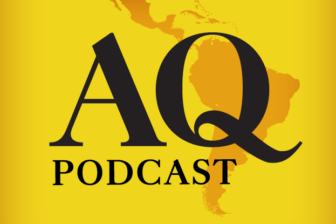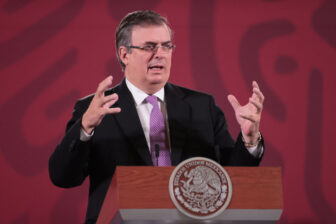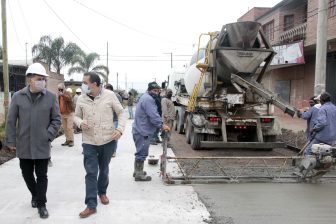“Facts, not words” — that was the slogan Mexico’s President Andrés Manuel López Obrador (AMLO) chose to promote his major September 1 speech to the nation. Government ads on social media touted 6% economic growth. But a closer look at the facts does not suggest optimism about the future of the Mexican economy.
This year will indeed witness an economic rebound of around 6.3%, one of the strongest in Latin America. But “recovery” might be a more appropriate term than “growth.” In 2020 the economy plummeted by 8.3%, while in 2019, AMLO’s first year in office, it shrank by 0.1%. By the end of 2021, economic growth over the course of the current administration is forecast to be -2.4%, still in negative territory.
Last week, the AMLO government presented its fourth annual economic package to Congress. Its macroeconomic assumptions show only slight changes from past years, though growth expectations for next year (4%) are 1% higher than market consensus. But the package contains a pleasant surprise in the form of two standout features, courtesy of new finance minister Rogelio Ramírez de la O.
One is a series of modifications that aim to improve and provide certainty to tax collection by closing loopholes and restricting discretionary interpretations of several tax-related laws. The other is the recognition, for the first time in the administration, of a need to move away from fiscal orthodoxy and run fiscal deficits of 0.4% and 0.3% for this year and next. Although both measures point in the right direction and will improve fiscal margins, their effects will fall well short of the structural changes that the Mexican economy desperately needs to lay the foundations for robust and sustained growth.
Although Mexico’s macroeconomic fundamentals still look sound, they will not remain so forever. Vulnerabilities are adding up, including an economic recovery that is too dependent on the U.S., increased poverty levels, and higher public debt — in an environment characterized by high uncertainty and the prospect of rising interest rates resulting from global efforts to contain inflation.
CONEVAL, an independent technical council that measures poverty, recently released its findings for 2018–2020. These show that the number of Mexicans living in poverty rose by 3.8 million to a total of 55.7 million, while extreme poverty increased by 2.1 million to reach 10.8 million. An additional 900,000 Mexicans lost access to education, and the number of those lacking access to healthcare rose by 15.6 million to 35.7 million. The main factor that explains this dramatic deterioration in healthcare access at the worst moment possible is the end of the Popular Insurance (Seguro Popular) program that had provided healthcare access to 52 million Mexicans. Its replacement, which is part of AMLO’s 4T project (“4T” stands for a potential “fourth transformation” of the Mexican economy), covers only 34 million.
Considering the broadest measurement of public debt employed by the finance ministry, Mexico’s debt-to-GDP ratio has increased over from 44.9% in 2018 to 54.7% in 2020, though it is expected to fall to 51% in 2021 and 2022. Mexico’s national oil company, Pemex, is the world’s most indebted, with $110 billion in outstanding financial debt. The company’s annual losses have worsened since 2019, when it notched a $18.3 billion loss, almost double that of the previous year. Losses spiked again to $23 billion in 2020.
Oil production has also been in constant decline — last year, Pemex’s oil output was 1.61 million barrels per day (MBPD). This represents a marked drop from the early 2000s, when the Cantarell oil field boosted production to as high as 3.4 MBPD. But it represents a deterioration even compared to the more modest 1.8 MBPD the company produced in 2018. Pemex’s response to its tenuous position and downgrades to its credit rating has been to build a new refinery, regardless of financial and environmental concerns, and terminate its rating contract with Fitch, one of the three largest credit rating agencies. Meanwhile, fiscal support to Pemex has totaled nearly 2% of GDP over the last three years.
Mexico’s current level of debt to GDP is manageable and certainly one of the lowest among OECD countries, particularly after its fiscal response to the pandemic — which was almost nonexistent, imposing a huge cost on lives and jobs. (Mexico allocated only 1.8% of its GDP, while the Latin American average was 8.5%.) But fiscal pressures are increasing from both mandatory and discretionary expenditures, such as enhanced pensions, highly politicized social programs, and questionable pet projects.
Preexisting firewalls that kept the economy robust and protected it from serious shocks have evaporated. A large part of Mexico’s stabilization fund was spent even before the pandemic. Since then, all the country’s trust funds — including those intended for health emergencies, but also natural disasters — have been fully exhausted, leaving Mexico for the first time in years without financial safety nets. Although tax revenues have increased since 2013, reaching 16.5% of GDP in 2019, they remain far from the average of OECD average of 33.8% and short of the Latin American average of 22.9%. Recent improvements in tax collection, though positive, are limited, relying on a one-off resolution of litigation dating back several years.
The current minister of finance now finds himself in a strong position, enjoying a degree of power that stems from his closeness to the president as well as from the policy choices he has made in the economic package. This will certainly provide him greater room to maneuver, but only enough to stabilize the country’s finances for the time being. From recent meetings with investors, it seems Ramírez de la O is determined to have a much larger say on Pemex. This is good news. A new strategy conducted from the finance ministry, promising to give coherence and a much-needed path to fiscal sustainability for this public enterprise, would be well timed. So would more concerted efforts to provide certainty to investment.
With half of the AMLO administration’s mandate already over, the current choice facing the Mexican economy is whether to move towards an urgent structural reset, or to remain caught in an unsustainable paradox. This paradox features, on the one hand, a lack of growth, retrenchment in productivity factors and a deteriorating security and institutional environment — and, on the other, increased expenditure on discretionary social programs, financially unviable pet projects and ideological nonsense in the energy sector. The response to this paradox will have enormous consequences for poverty, health, education, jobs, infrastructure, and productivity, and on the future well-being of more than 126 million Mexicans.









